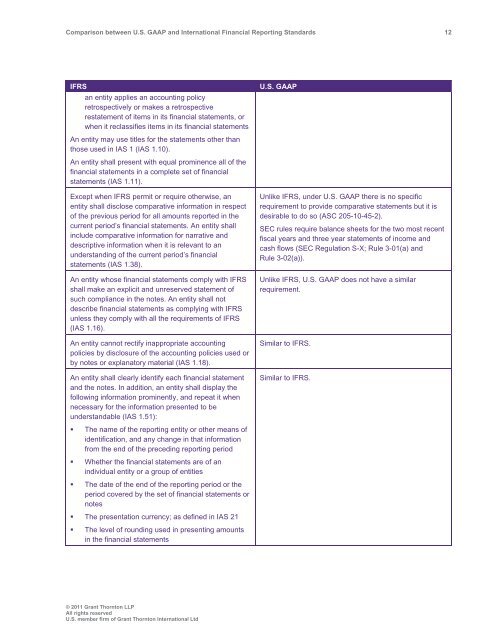Comparison between U.S. GAAP and International ... - Grant Thornton
Comparison between U.S. GAAP and International ... - Grant Thornton
Comparison between U.S. GAAP and International ... - Grant Thornton
Create successful ePaper yourself
Turn your PDF publications into a flip-book with our unique Google optimized e-Paper software.
<strong>Comparison</strong> <strong>between</strong> U.S. <strong>GAAP</strong> <strong>and</strong> <strong>International</strong> Financial Reporting St<strong>and</strong>ards 12<br />
IFRS<br />
an entity applies an accounting policy<br />
retrospectively or makes a retrospective<br />
restatement of items in its financial statements, or<br />
when it reclassifies items in its financial statements<br />
An entity may use titles for the statements other than<br />
those used in IAS 1 (IAS 1.10).<br />
An entity shall present with equal prominence all of the<br />
financial statements in a complete set of financial<br />
statements (IAS 1.11).<br />
Except when IFRS permit or require otherwise, an<br />
entity shall disclose comparative information in respect<br />
of the previous period for all amounts reported in the<br />
current period’s financial statements. An entity shall<br />
include comparative information for narrative <strong>and</strong><br />
descriptive information when it is relevant to an<br />
underst<strong>and</strong>ing of the current period’s financial<br />
statements (IAS 1.38).<br />
An entity whose financial statements comply with IFRS<br />
shall make an explicit <strong>and</strong> unreserved statement of<br />
such compliance in the notes. An entity shall not<br />
describe financial statements as complying with IFRS<br />
unless they comply with all the requirements of IFRS<br />
(IAS 1.16).<br />
An entity cannot rectify inappropriate accounting<br />
policies by disclosure of the accounting policies used or<br />
by notes or explanatory material (IAS 1.18).<br />
An entity shall clearly identify each financial statement<br />
<strong>and</strong> the notes. In addition, an entity shall display the<br />
following information prominently, <strong>and</strong> repeat it when<br />
necessary for the information presented to be<br />
underst<strong>and</strong>able (IAS 1.51):<br />
U.S. <strong>GAAP</strong><br />
Unlike IFRS, under U.S. <strong>GAAP</strong> there is no specific<br />
requirement to provide comparative statements but it is<br />
desirable to do so (ASC 205-10-45-2).<br />
SEC rules require balance sheets for the two most recent<br />
fiscal years <strong>and</strong> three year statements of income <strong>and</strong><br />
cash flows (SEC Regulation S-X; Rule 3-01(a) <strong>and</strong><br />
Rule 3-02(a)).<br />
Unlike IFRS, U.S. <strong>GAAP</strong> does not have a similar<br />
requirement.<br />
Similar to IFRS.<br />
Similar to IFRS.<br />
• The name of the reporting entity or other means of<br />
identification, <strong>and</strong> any change in that information<br />
from the end of the preceding reporting period<br />
• Whether the financial statements are of an<br />
individual entity or a group of entities<br />
• The date of the end of the reporting period or the<br />
period covered by the set of financial statements or<br />
notes<br />
• The presentation currency; as defined in IAS 21<br />
• The level of rounding used in presenting amounts<br />
in the financial statements<br />
© 2011 <strong>Grant</strong> <strong>Thornton</strong> LLP<br />
All rights reserved<br />
U.S. member firm of <strong>Grant</strong> <strong>Thornton</strong> <strong>International</strong> Ltd
















